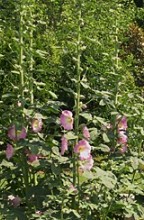 A native of southwestern China, this hollyhock is a member of the mallow family, Malvaceae, and related to hibiscus, cotton, okra, and cacao. It may be an annual, biennial, or short lived perennial depending on the climate, but self seeds readily so returns year after year to most gardens. The large flowers are carried in racemes on tall erect stems and come in a large variety of colors including dark red, pink, orange, yellow, lavender and white. Plants grow up to eight feet tall and are a good choice for the back of the border. They like full to part sun and well-drained soil but some varieties tolerate clay soil.
A native of southwestern China, this hollyhock is a member of the mallow family, Malvaceae, and related to hibiscus, cotton, okra, and cacao. It may be an annual, biennial, or short lived perennial depending on the climate, but self seeds readily so returns year after year to most gardens. The large flowers are carried in racemes on tall erect stems and come in a large variety of colors including dark red, pink, orange, yellow, lavender and white. Plants grow up to eight feet tall and are a good choice for the back of the border. They like full to part sun and well-drained soil but some varieties tolerate clay soil.
 The flavor of hollyhock flowers is mild but the color they add to a dish is notable. They can be added to salads, used to make tea, and to color baked such dishes as scones, creams, and clafouti. Hollyhock cafouti with cherries is an especially attractive dessert.
The flavor of hollyhock flowers is mild but the color they add to a dish is notable. They can be added to salads, used to make tea, and to color baked such dishes as scones, creams, and clafouti. Hollyhock cafouti with cherries is an especially attractive dessert.
All parts of the plant are edible, although the stem and leaves leave something to be desired in regard to texture. The flowers have been used to treat a variety of ills including constipation, inflammation, menstrual cramps, sore throat, circulatory problems, and chest complaints.
Flowers should be harvested when they are open. Petals should be removed individually from the calyx and pistil. They may be used immediately or dried for later use. Six to twelve flowers yields a cup of petals.